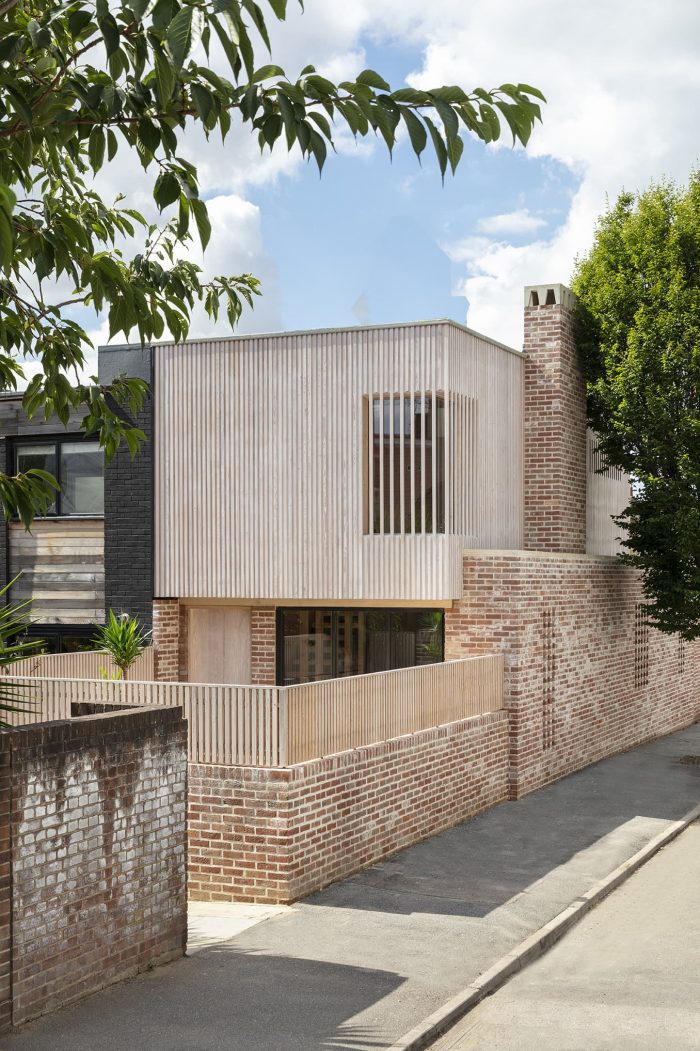莱顿之家为一位电影制片人和作家提供了一个新家。该设计重新构想了一个被忽视的狭窄地块,它位于一个20世纪60年代的排屋的末端,该排屋建在一个二战时期的炸弹的位置。我们的任务是最大限度地发挥填充地块的潜力,创造一个适合客户当前要求的生活和工作空间,同时也有可能随着环境的变化而适应和发展。
Leyton House forms a new home for a filmmaker and writer. The design reimagines a neglected, narrow plot that sits at the end of a 1960s terrace built on the site of a World War 2 bomb. The brief was to maximize the potential of the infill site creating a space to live and work that suits the client’s current requirements but also has the potential to adapt and grow as circumstances change.
经过两年的漫长过程,说服规划师接受现代和当代的设计方法,最终获得批准,建造一座三层楼的房子,尊重邻近的60年代露台的精神,同时解决邻近街道的维多利亚时代背景。打开场地的关键是利用地下的潜力,将地下空间整合到规划布局中。复杂的结构工程被用来创建一个全长的地下室。
A lengthy two-year process was undertaken to convince the planners to embrace a modern and contemporary design approach that ultimately gained approval for a three-story house that respects the spirit of the adjacent ’60s terrace while addressing the Victorian context of the neighboring street. The key to unlocking the site was utilizing the below-ground potential and integrating subterranean spaces into the plan layout. Complex structural works were undertaken to create a full-length basement.
预算限制意味着没有主承包商,每个包都是单独管理。与作为项目经理的客户的紧密合作是非常重要的,这个过程需要建筑团队的奉献,他们热情地接受了整体设计。该项目由其元素性质决定,由街道层面的砖砌基座和上面精细的木制框架结构组成。地下室围绕两个庭院形成,使日光能够深入到规划中。简单的形式由一个雕塑般的砖制烟囱完成,它点缀了整个构图,并形成了开放式底层的一个焦点。
Budget constraints meant that there was no main contractor, and each package was separately managed. Close collaboration with the client – who acted as project manager – was essential and the process required dedicated commitment from the building team who enthusiastically bought into the overall design. The project is defined by its elemental nature and is composed of a brick plinth at street level with a finely detailed timber framed structure above. The basement below is formed around two courtyards that enable daylight to penetrate deep into the plan. The simple form is completed by a sculptural brick chimney, which punctuates the overall composition and forms a focal point for the open-plan ground floor.
为了适应不同的环境,我们选择了一种柔软的红砖,混凝土细节和白色石灰砂浆扩大了坚实的单体基础。一楼的西伯利亚落叶松木制品用白油装饰,创造了一个统一的构图,表达了上层和下层体量之间的构造关系。这些形式在整个场地上被微妙地衔接起来,解决了街道和角落的环境问题。地面和一楼之间的后退创造了一个沿着居住区长度延伸的屋顶灯。木质托梁暴露在内部,调节入射光线,创造阴影,丰富了整个空间。一个连续的现浇混凝土长凳将厨房、餐厅和起居区划分开来,形成一个构造简单而有序的空间。
A soft, reddish brick was chosen to suit the varied context, with concrete detailing and flush white lime mortar amplifying the solid monolithic base. Siberian Larch timberwork at the first-floor level is finished in white oil, creating a unified composition that expresses the tectonic relationship between the upper and lower volumes. The forms are subtlely articulated across the site, addressing the street and corner context. A setback between the ground and the first floor creates a roof light extending along the length of the living area. Timber joists are exposed internally, modulating incoming light and creating shadows that enrich the space throughout the day. A continuous in-situ concrete bench demarcates the kitchen, dining, and living areas forming a tectonically simple and ordered space.
面向街道的外部窗户被屏蔽以保护隐私,强调了体量的基本性质。大面积的玻璃窗与内部庭院相连,一楼有一扇图画窗,可以看到远处的城市景观。内部采用了温暖、自然的材料调色板–部分灵感来自于客户在墨西哥生活的时间–混凝土、砖和木材随着从公共场所到私人场所的进展而变得柔和。一面粘土墙将所有三层楼连接起来,在地下室,不同色调的粘土包裹着墙壁和天花板,创造出一种封闭和温暖的感觉。一个顶部照明的楼梯打开了,让光线照射到整个房间。通过材料的完整性和仔细的细节设计,该建筑试图创造一种慷慨的空间和平静,而这是原址没有立即表明的可能性。
Street-facing external windows are screened for privacy, emphasizing the elemental nature of the volumes. Large glazed openings link to internal courtyards and a picture window is formed on the first floor, framing distant views of the city beyond. Internally a warm, natural palette of materials is employed – inspired in part by the client’s time spent living in Mexico – with concrete, brick, and timber softening as progress is made from public to private. A clay plaster wall links all three floors and at the basement level, different tones of clay wrap the walls and ceilings creating a feeling of enclosure and warmth. A top-lit staircase opens up to allow light to wash throughout. Through material integrity and careful detailing the building seeks to create a generosity of space and calmness that the original site did not immediately suggest was possible.
Architects: McMahon Architecture
Area : 188 m²
Year : 2022
Photographs :Fernando Manoso
Manufacturers : CREST, Cambridge Joinery , Clay-works, DSM Steel Design , Grovecourt, Maxlight, Sunseeker
Lead Architect : Louise McMahon
Mechanical Engineer : Werninck Building Services
Contractor : Refab Build
Country : United Kingdom






















